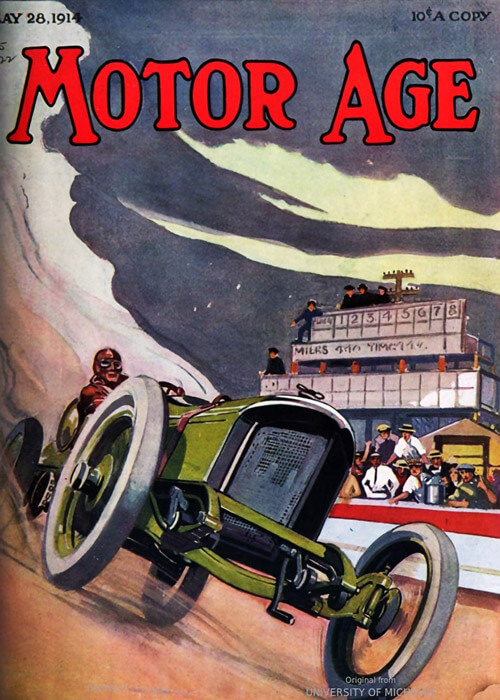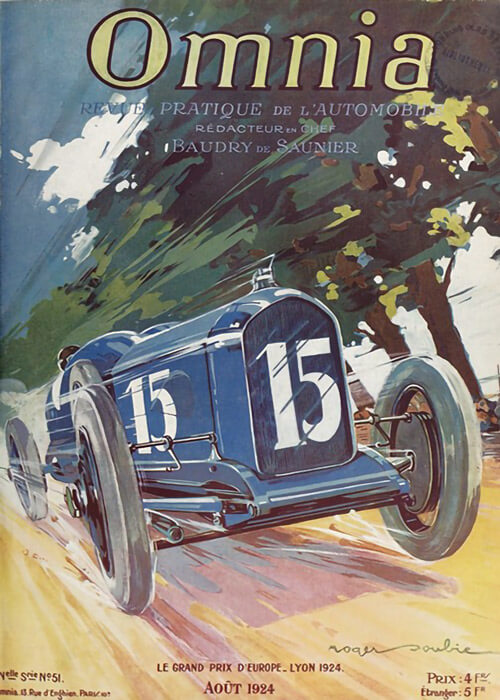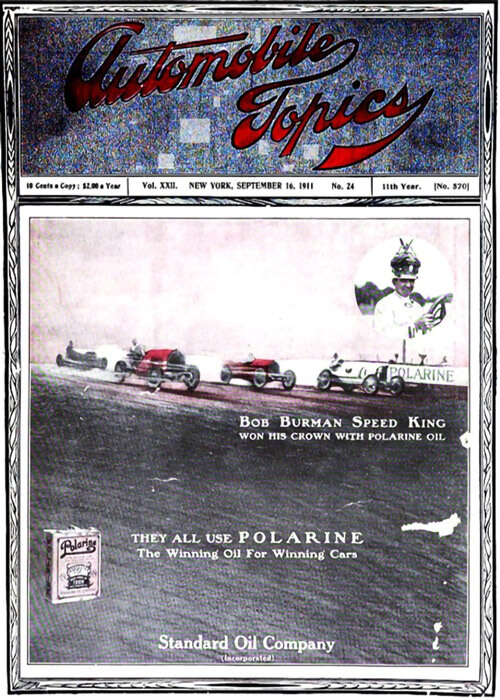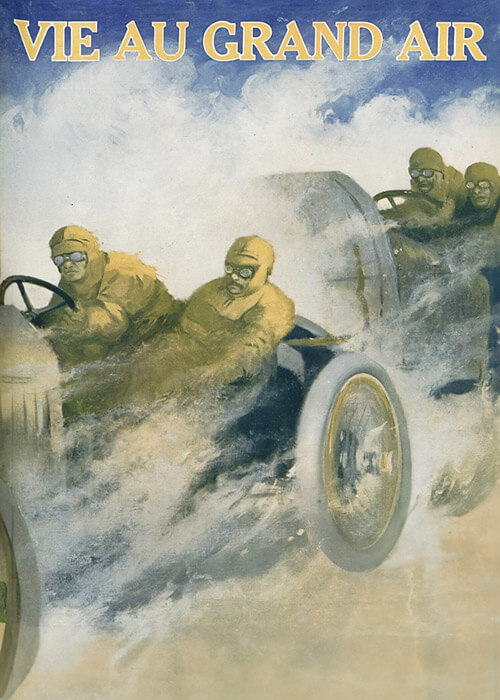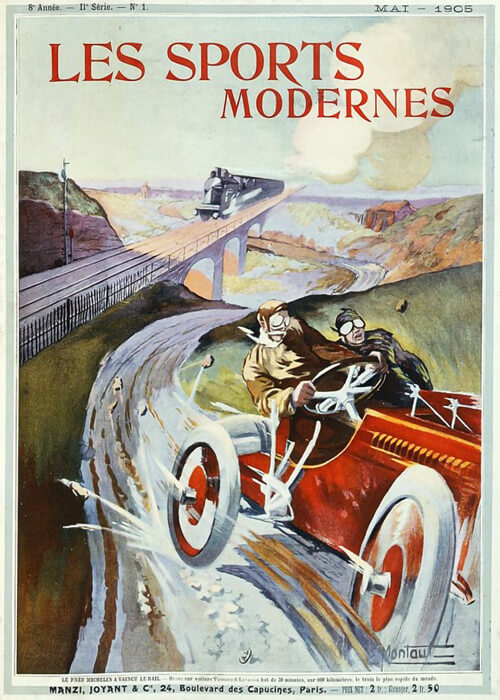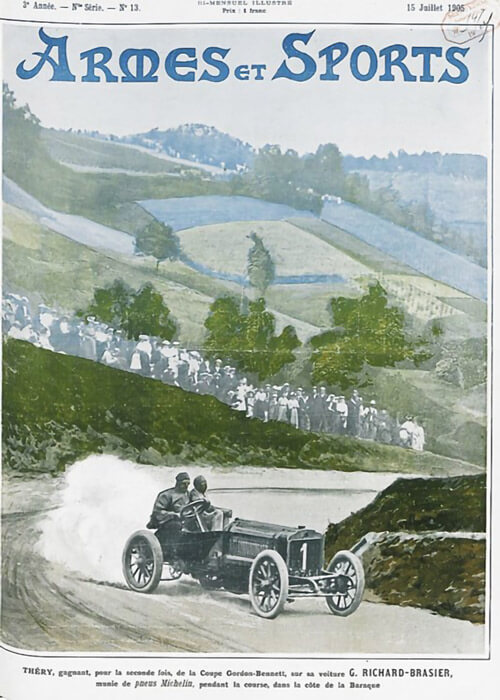Although in 1922 the Monza racetrack was built on which Italy’s first Grand Prix was held, still the Targa Florio was very popular for many automotive manufacturer. It was even the first time that contestant not only from Italy, but also France, Germany and Austria participated. This years XIII Targa was won by the Italian Masetti in a Mercedes 4.5 liter from 1914, that he had acquired some weeks before the race. His car was painted red and as such distinghuisable from the white works Mercedeses, of which some even were equipped with a Roots compressor! In fact, the first time ever that a supercharger was used in a race.
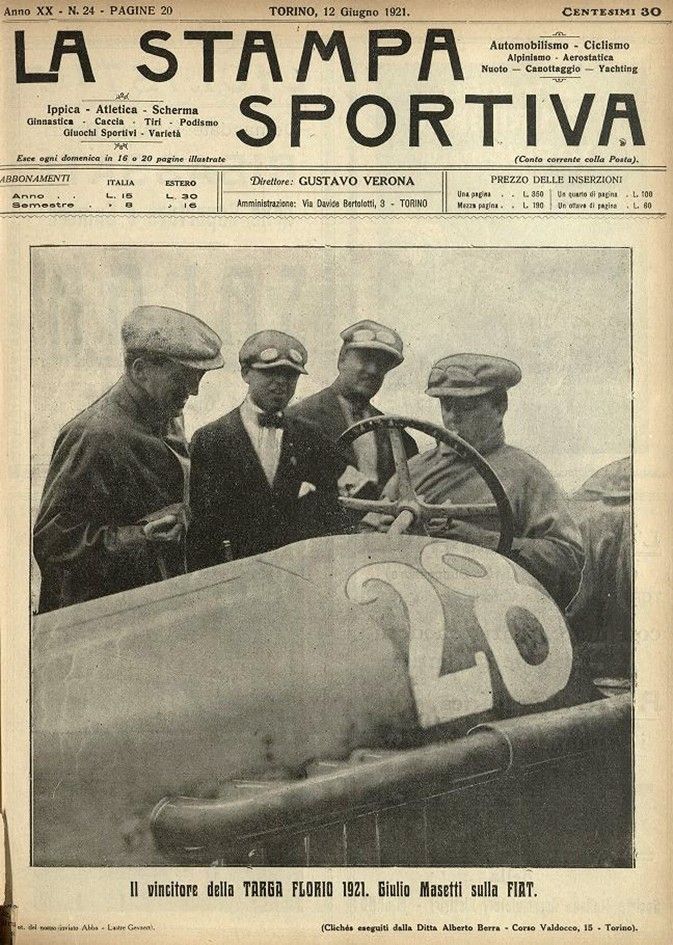
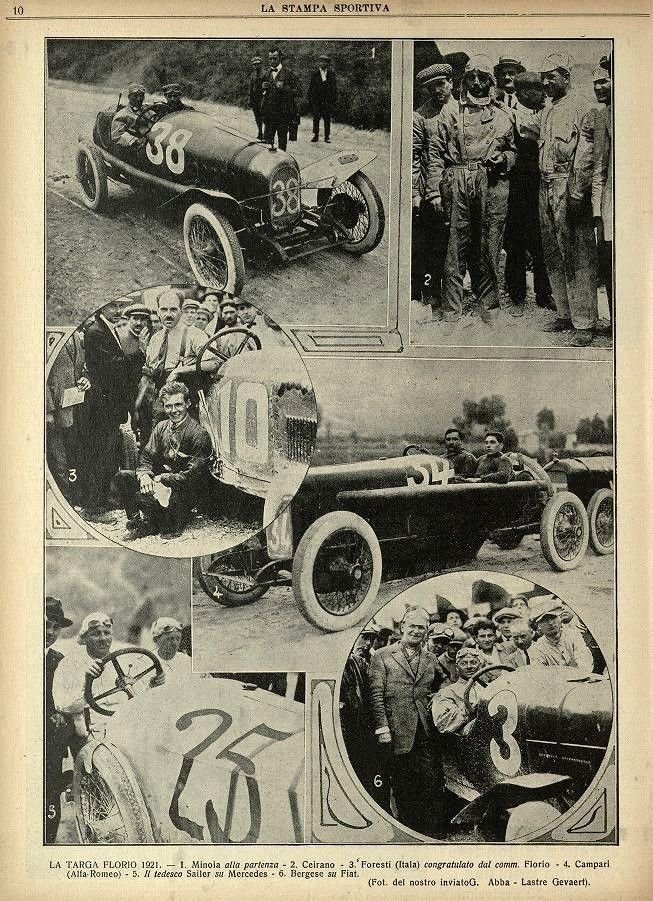
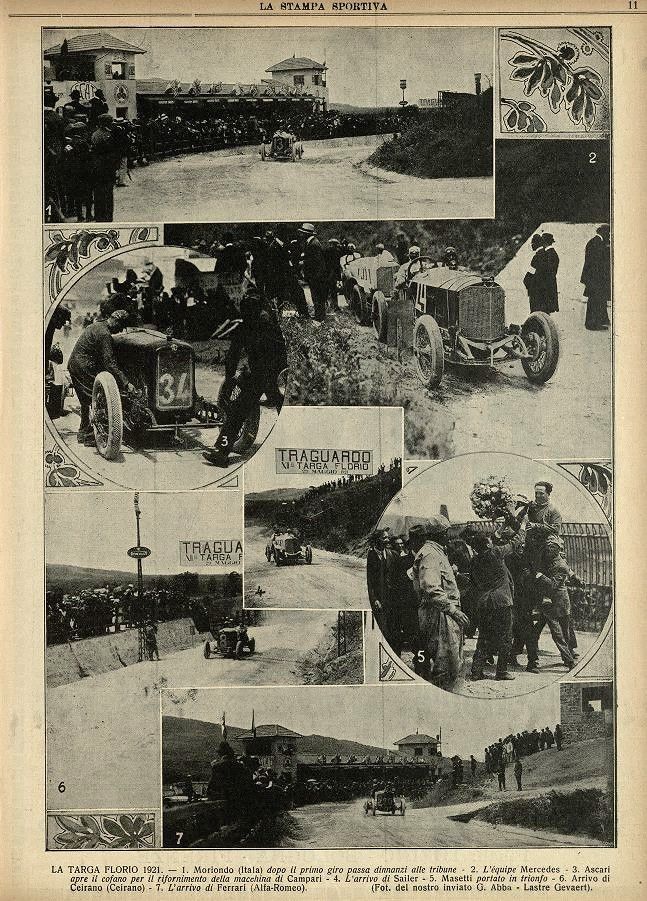
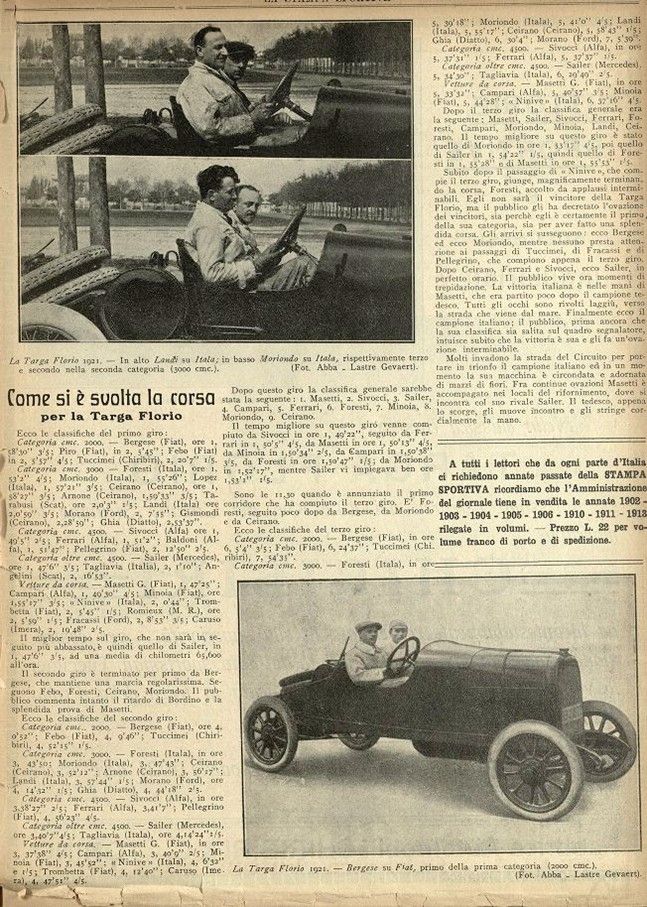
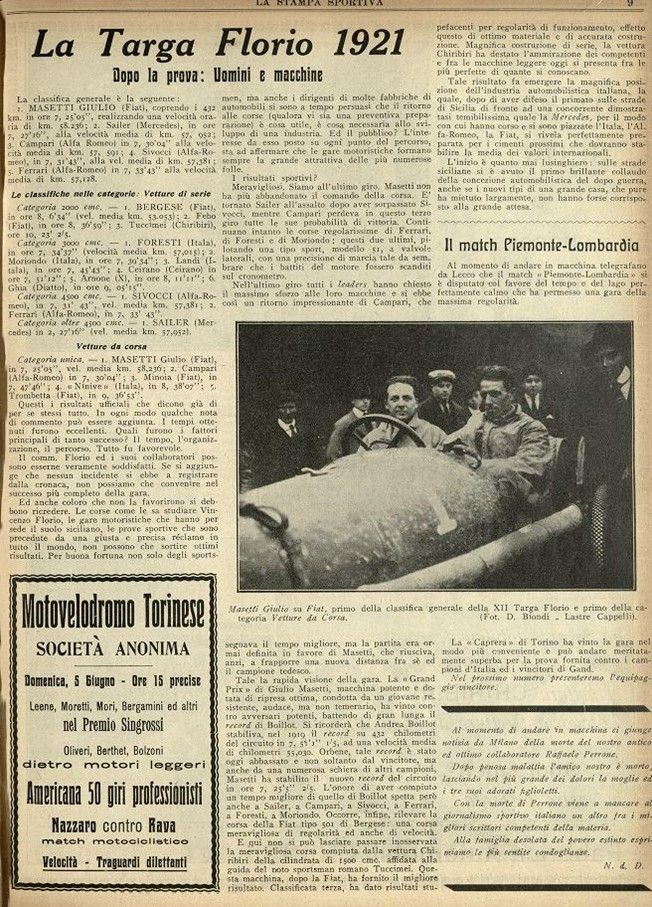
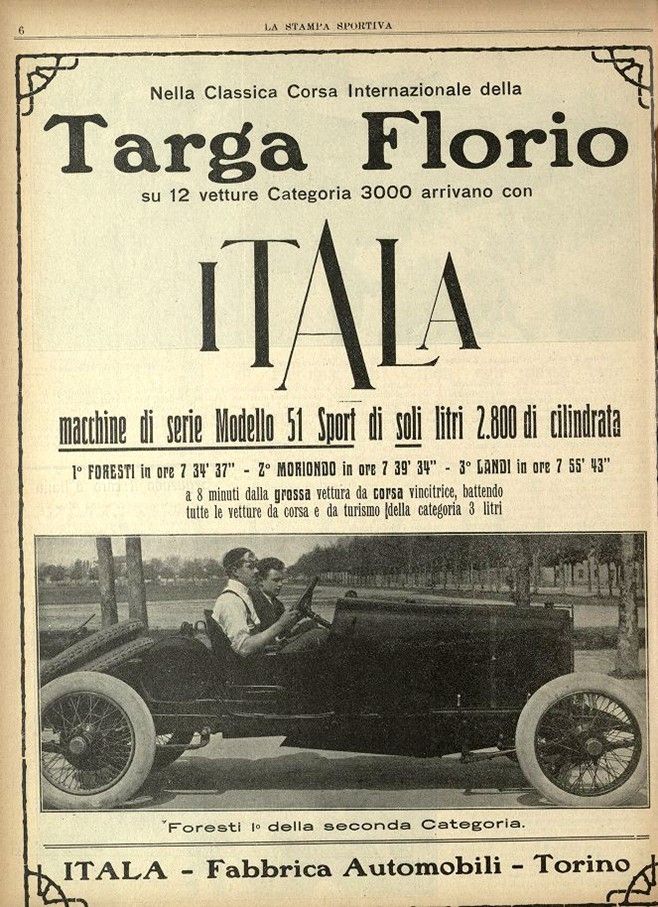
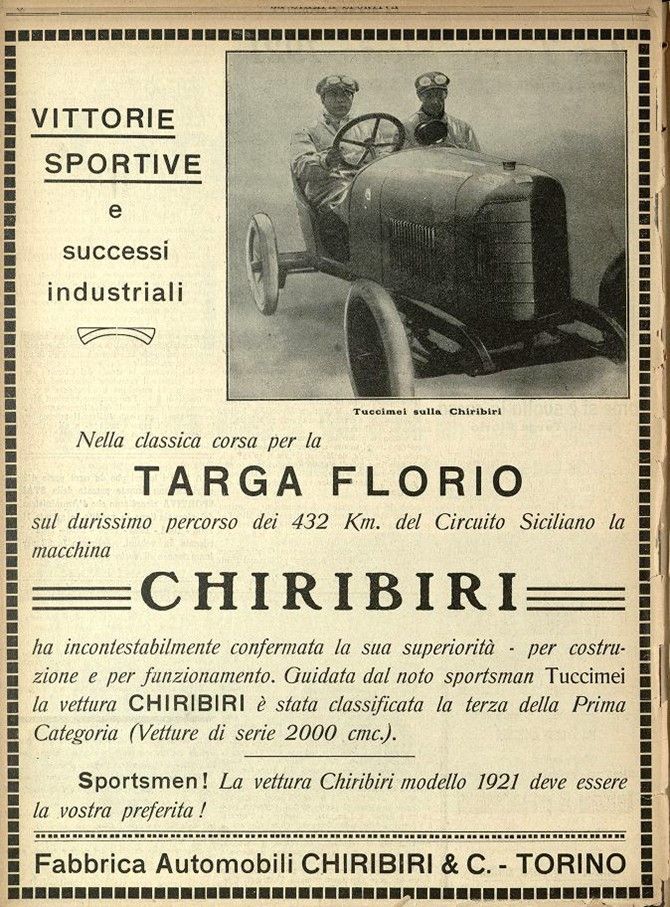


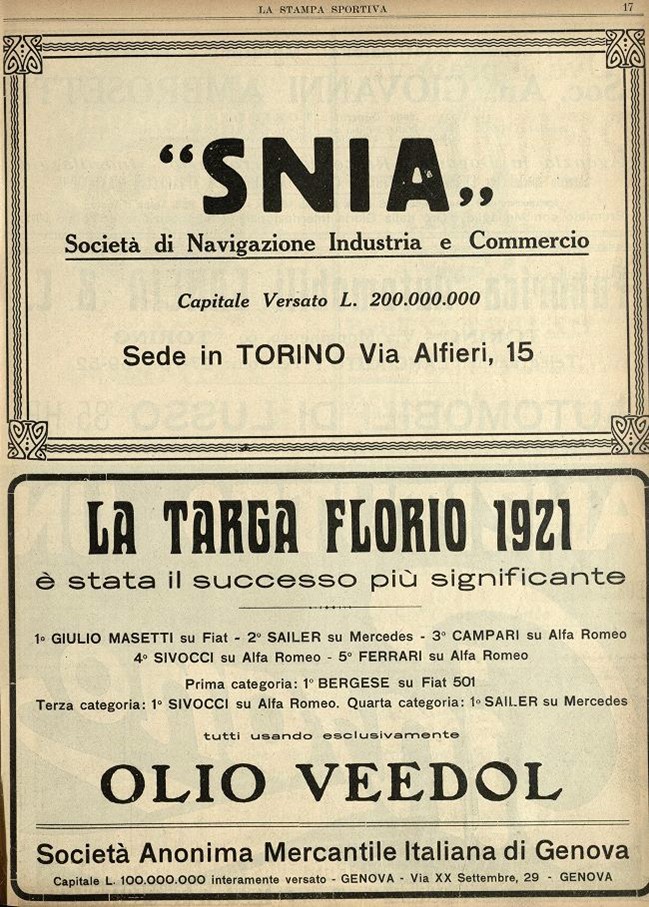
Text and fotos with courtesy of Museo dell’Automobile di Torino, byterfly.eu compiled by motorracinghistory.com
La Stampa Sportiva, Anno XX, N. 15+16, Torino, 8+12 gugno 1921
Il vincitore della TARGA FLORIO 19Z1. Giulio Mosetti sulla FIAT.
(Fot. del nostro Inviato Abba – Lastre Gevaert). (Clichés eseguiti dalla Ditta Alberto Berrà – Corso Valdocco, 15 – Torino).
LA TARGA FLORIO 1921. — 1. Minoia alla partenza – 2. Ceirano – 3. Foresti (Itala) congratulato dal comm. Florio – 4. Campari (Alfa-Romeo) – 5. Il tedesco Sailer su Mercedes – 6. Bergese su Fiat. (Fot. del nostro inviatoG. Abba – Lastre Gevaert).
LA TARGA FLORIO 1921. — 1. Moriondo (Itala) dopo il primo giro passa dinnanzi alle tribune – 2. L’équipe Mercedes – 3. Ascari apre il cofano per il rifornimento della macchina di Campari – 4. L’arrivo di Sailer – 5. Masetti portato in trionfo – 6. Arrivo di Ceirano (Ceirano) – 7. L’arrivo di Ferrari (Alfa-Romeo). (Fot. del nostro inviato G. Abba – Lastre Gevaert).
Come si è svolta la corsa per la Targa Florio
Ecco le classifiche del primo giro:
Categoria cmc. 2000. — Bergese (Fiat), ore 1
Categoria cmc. 3000. — Foresti (Itala), ore 1
Categoria cmc. 4500. — Sivocci (Alfa) ore 1
Categoria oltre cmc. 4500. — Sailer (Mercedes),
** part of of the original ocr was hardly to decipher **
Vetture da corsa. — Masetti G. (Fiat), 1, 47’25“; Campari (Alfa), 1, 49’30“ 4/5; Minoia (Fiat), ore 1, 55’17″ 3’5; «Ninive» (Itala), 2, 0’44“ Trombetta (Fiat), 2, 5’45“ 1/5; Romieux (M. R.), ore 2, 5’59“ 1/5; Fracassi (Ford), 2, 8’53“; Caruso, (Imera), 2, 19’48“ 2/5.
Il miglior tempo sul giro, che non sarà in, seguito più abbassato, è quindi quello di Sailer, in 1, 47’6″ 3/5, ad una media di chilometri 65,600 all’ora.
Il secondo giro è terminato per primo da Bergese, che mantiene una marcia regolarissima. Seguono Febo, Foresti, Ceirano, Moriondo. Il pubblico commenta intanto il ritardo di Bordino e la splendida prova di Masetti.
Ecco le classifiche del secondo giro:
Categoria cmc. 2000. — Bergese (Fiat), ore 4, 0’52“; Febo (Fiat), 4, 9’46“; Tuccimei (Chiribiri), 4, 52’15″ 1/5.
Categoria cmc. 3000. — Foresti (Itala), in ore 3, 43’5; Moriondo (Itala), 3, 47’43“; Ceirano (Ceirano), 3, 52’12″; Arnone (Ceirano), 3, 56T7″; Landi (Itala), 3, 57’44“ 1/5; Morano (Ford), ore 4, 14’32“ 1/5; Ghia (Diatto), 4, 44’18“
Categoria cmc. 4500. — Sivocci (Alfa), in ore 3,38*27″ 2/5; Ferrari (Alfa), 3,41*7″; Pellegrino (Fiat), 4, 56’23″ 4/5.
Categorìa oltre cmc. 4500. — Sailer (Mercedes), ore 3,40’7″4’5; Tagliavia (Itala), ore 4, 14’24″1/5.
Vetture da corsa. — Masetti G. (Fiat), in ore 3, 37’38″ 4/5; Campari (Alfa), 3, 40’9″ 2/5; Minoia (Fiat), 3, 45’*52″; «Ninive» (Itala), 4, 6’32“ e 1/5; Trombetta (Fiat), 4, 12’40“; Caruso (Imera), 4, 47’51″ 4/5.
Dopo questo giro la classifica generale sarebbe stata la seguente: 1. Masetti, 2. Sivocci, 3. Sailer, 4. Campari, 5. Ferrari, 6. Foresti, 7. Minoia, 8. Moriondo, 9. Ceirano.
Il tempo migliore su questo- giro venne compiuto da Sivocci in ore i, 49’22’*, seguito da Ferrari in 1, 50’5″ 4’5, da Masetti in ore 1, 50’13″ 4/5, da Minoia in 1, 50’34“ a’5, da Campari in 1, 50’38“ 3/5, da Foresti in ore 1,50’47″ 1/5; da Moriondo in ‚1,52‘ 17″, mentre Sailer vi impiegava ben ore 1,53’1″ 1/5.
Sono le 11,30 quando è annunziato il primo corridore che ha compiuto il terzio giro. È Foresti, seguito poco dopo da Bergese, de Moriondo e da Ceirano.
Ecco, le classifiche del terzio giro:
Categoria cmc. 2000. — Bergese (Fiat), ore 1, „58’30“ 3/5; Piro (Fiat), in 2, 5’45“; Febo (Fiat) 6, 24’7”; Tuccimei (Chiribiri), 7, 54’35“.
Categoria cmc. 3000 — Foresti (Itala), in ore 5, 39′ 18″; Moriondo (Itala), 5, 41’ 0″ 4/5; Landi (Itala), 5, 55′ 17″; Ceirano (Ceirano), 5, 58’43“ 1/5; Ghia (Diatto), 6, 30’4″; Morano (Ford), 7, 5’39.
Categoria cmc. 4500. — Sivocci (Alfa), in ore 5, 37’ 31 “ 1/5; Ferrari (Alfa), 5, 37’37“ 1/5.
Categoria oltre cmc. 4500. — Sailer (Mercedes), 5, 34’30“; Tagliavia (Itala), 6, 29’49“ 2/5.
Vetture da corsa. — Masetti G. (Fiat), in ore 5, 33’32“; Campari (Alfa), 5, 4°’57“ 3/5; Minoia (Fiat), 5, 44’28“; «Ninive» (Itala), 6, 37’16“ 4/5.
Dopo il terzo giro la classifica generale era la seguente: Masetti, Sailer, Sivocci, Ferrari, Foresti, Campari, Moriondo, Minoia, Landi, Ceirano.
Il tempo migliore su questo giro è stato quello di Moriondo in ore 1, 53*17″ 4;5, poi quello di Sailer in 1, 54’22“ 1/5, quindi quello- di Fore-sti in 1, 55’28“ e di Masetti in ore 1, 55’53″ 1/5.
Subito dopo il passaggio di «Ninive», che compie il terzo giro, giunge, magnificamente terminando la corsa, Foresti, accolto da applausi interminabili. Egli non sarà il vincitore della Targa Florio, ma il pubblico gli ha decretato l’ovazione dei vincitori, sia perché egli è certamente il primo, della sua categoria, sia per aver fatto una splendida corsa. Gli arrivi si susseguono: ecco Bergese ed ecco Moriondo-, mentre nessuno presta attenzione ai passaggi di Tuccimei, di. Fracassi e di Pellegrino, che compiono appena il terzo giro. Dopo Ceirano, Ferrari e Sivocci, ecco Sailer in perfetto orario. Il pubblico vive ora momenti di trepidazione. La vittoria italiana è nelle mani di Masetti, che era partito poco- dopo- il campione tedesco. Tutti gli occhi sono rivolti laggiù, verso la strada che viene dal mare. Finalmente ecco il campione italiano; il pubblico, prima ancora che la sua classifica sia salita sul quadro segnalatore, intuisce subito che la vittoria è sua e gli fa un’ovazione interminabile.
Molti invadono la strada del Circuito per portare in trionfo il campione italiano ed in un momento la sua macchina è circondata e adornata di mazzi di fiori. Fra continue ovazioni Masetti è accompagnato nei locali del rifornimento, dove si incontra col suo rivale Sailer. Il tedesco, appena lo scorge, gli muove incontro, e gli stringe cordialmente la mano.
Foto.
La Targa Florio 1921. — In alto Landi su Itala; va basso Moriondo su Itala, rispettivamente terzo e secondo nella seconda categoria (3000 cmc.).
(Fot. Abba – Lastre Gevaert).
La Targa Florio 1921. – Bergese su Fiat, primo della prima categoria (2000 cmc.).
(Fot. Abba – Lastre Gevaert).
———-
Page 9 – La Targa Florio 1921 – Dopo la prova: Uomini e macchino
La classifica generale è la seguente:
1. MASETTI GIULIO (Fiat), coprendo i 432 km. in ore 7, 25’05“, realizzando una velocità oraria di km. 58.236; 2. Sailer (Mercedes), in ore 7 27’16“, alla velocità media di km. 57,952; 3. Campari (Alfa Romeo) ini 7, 30’04“ alla velocità media di km. 57, 591; 4. Sivocci (Alfa-Romeo), in 7, 31’43“, alla vel. media di km. 57,381; 5. Ferrari (Alfa-Romeo) in 7, 33’43“ alla velocità media di km. 57,128.
Le classifiche nelle categorie: Vetture dì serie
Categoria 2000 cmc. — 1. BERGESE (Fiat), in ore 8, 6’34“ (vel. media km. 53-053); 2. Febo (Fiat), in ore 8, 36’59“; 3. Tuccimei (Chiribiri), ore 10, 23′ 2/5.
Categoria 3000 cmc. — 1. FORESTI (Itala), in ore 7, 34’37“ (velocità media km. 57,015), 2. Moriondo (Itala), in ore 7, 39’34“, 3. Landi (Itala), in ore 7, 45’43“; 4. Ceirano (Ceirano) in ore 7, 51’12″; 5. Arnone (X), in ore 8, 11’11“; 6. Ghia (Diatto), in ore 9, 05’15″.
Categoria 4500 cmc. — 1. SIVOCCI (Alfa-Romeo), in 7, 31′ 43″, vel. media km. 57,381; 2. Ferrari (Alfa-Romeo), in 7, 33′ 43″.
Categoria oltre 4500 cmc. — 1. SAILER (Mercedes) in 2, 27’ 16″ (vel. media km. 57,952).
Vetture da corsa
Categoria unica. — 1. MASETTI Giulio (Fiat), in 7, 25’05“, vel. media km. 58,236; 2. Campari (Alfa-Romeo) in 7, 30’04“; 3. Minoia (Fiat), in 7, 47’46“; 4. «Ninive» (Itala), in 8, 38’07“; 5. Trombetta (Fiat), in 9, 36’53.
Questi i risultati ufficiali che dicono già di per sé stessi tutto. In ogni modo qualche nota di commento può essere aggiunta. I tempi ottenuti furono eccellenti. Quali furono i fattori principali di tanto successo? 11 tempo, l’organizzazione, il percorso. Tutto fu favorevole.
Il comm. Florio ed i suoi collaboratori possono esserne veramente soddisfatti. Se si aggiunge che nessun incidente si ebbe a registrare dalla cronaca, non possiamo che convenire nel successo più completo della gara.
Ed anche coloro che noni la favorirono si debbono ricredere. Le corse come le sa studiare Vincenzo Florio, le gare motoristiche che hanno per sede il suolo siciliano, le prove sportive che sono precedute da una giusta e precisa réclame in tutto il mondo, non possono che sortire ottimi risultati. Per buona fortuna non solo degli sportsmen, ma anche i dirigenti di molte fabbriche di automobili si sono a tempo persuasi che il ritorno alle corse (qualora vi sia una preventiva preparazione) è cosa utile, è cosa necessaria allo sviluppo di una industria. Ed il pubblico? L’interesse da esso posto su ogni 1 punto del percorso sta ad affermare che le gare motoristiche formano sempre la grande attrattiva delle più numerose folle.
I risultati sportivi?
Meravigliosi. Siamo all’ultimo giro. Masetti non ha più abbandonato il comando della corsa. E ‘tornato Sailer all’assalto dopo aver sorpassato Sivocci, mentre Campari perdeva in questo terzo giro tutte le sue probabilità di vittoria. Continuano intanto le corse regolarissime di Ferrari, di Foresti e di Moriondo : questi due ultimi, pilotando una tipo sport, modello 51, a valvole laterali, con una precisione di marcia tale da sembrare che i battiti del motore fossero scanditi sul cronometro.
Nell’ultimo giro tutti i leaders hanno chiesto il massimo sforzo alle loro macchine e si ebbe così un ritorno impressionante di Campari, che segnava il tempo migliore, ma la partita era ormai definita in favore di Masetti, che riusciva, anzi, a frapporre una nuova distanza fra sé ed il campione tedesco.
Tale la rapida visione della gara. La «Grand Prix» di Giulio Masetti, macchina potente e dotata di ripresa ottima, condotta da un giovane resistente, audace, ma non temerario, ha vinto contro avversari potenti, battendo di gran lunga il record di Boillot. Si ricorderà che Andrea Boillot stabiliva, nel 1919 il record su 432 chilometri del circuito in 7, 51’ 1″ 1/5, ad una velocità media di chilometri 55,030. Orbene, tale record è stato oggi abbassato e non soltanto dal vincitore, ma anche da una numerosa schiera di altri campioni, Masetti ha stabilito il nuovo- record del circuito in ore 7, 25’s“ 2/5. L’onore di aver compiuto un tempo migliore di quello di Boillot spetta però anche a Sailer, a Campari, a Sivocci, a Ferrari, a Foresti, a Moriondo. Occorre, infine, rilevare la corsa della Fiat tipo 501 di Bergese: una corsa meravigliosa di regolarità ed anche di velocità.
E qui non. si può lasciare passare inosservata la meravigliosa corsa compiuta dalla vettura Chiribiri della cilindrata di 1500 cmc. affidata alla guida del noto sportsman romano Tuccimei. Questa macchina, dopo la Fiat, ha fornito il migliore risultato. Classificata terza, ha dato risultati stupefacenti per regolarità di funzionamento, effetto questo di ottimo materiale e di accurata costruzione. Magnifica costruzione di serie, la vettura Chiribiri ha destato l’ammirazione dei competenti e fra le macchine leggere oggi si presenta fra le più perfette di quante si conoscano.
Tale risultato fa emergere la magnifica posizione dell’industria automobilistica italiana, la quale, dopo di aver difeso il primato sulle strade di Sicilia di fronte ad una concorrente dimostratasi temibilissima quale la Mercedes, per il modo con cui hanno corso e si sono piazzate l’Itala, l’Alfa-Romeo, la Fiat, si rivela perfettamente preparata per i cimenti prossimi che dovranno stabilire la media dei valori internazionali.
L’inizio è quanto mai lusinghiero: sulle strade siciliane si è avuto il primo brillante collaudo della concezione automobilistica del dopo guerra, anche se i nuovi tipi di una grande casa, che pure ha mietuto largamente, non hanno forse corrisposto alla grande attesa.
Foto.
Masetti Giulio su Fiat, primo della classifica generale della XII Targa Florio e primo della categoria Vetture da Corsa. (Fot. D. Biondi – Lastre Cappelli).
Translation by DeepL.com 20.04.2025 (Cliché ~ foto)
LA STAMPA SPORTIVA
The winner of the 19Z1 TARGA FLORIO. Giulio Mosetti in a FIAT.
(Photo by our correspondent Abba – Lastre Gevaert). (Clichés produced by Alberto Berrà – Corso Valdocco, 15 – Turin).
THE 1921 TARGA FLORIO. — 1. Minoia at the start – 2. Ceirano – 3. Foresti (Itala) congratulated by Comm. Florio – 4. Campari (Alfa-Romeo) – 5. The German Sailer in a Mercedes – 6. Bergese in a Fiat. (Photo by our correspondent G. Abba – Lastre Gevaert).
THE 1921 TARGA FLORIO. — 1. Moriondo (Itala) passes in front of the grandstands after the first lap – 2. The Mercedes team – 3. Ascari opens the bonnet to refuel Campari’s car – 4. Sailer’s arrival – 5. Masetti carried in triumph – 6. Arrival of Ceirano (Ceirano) – 7. The arrival of Ferrari (Alfa-Romeo). (Photo by our correspondent G. Abba – Gevaert).
How the Targa Florio race unfolded
Here are the rankings for the first lap:
Category cmc. 2000. — Bergese (Fiat), 1 hour
Category cmc. 3000. — Foresti (Itala), 1 hour
Category cmc. 4500. — Sivocci (Alfa) 1 hour
Category over cmc. 4500. — Sailer (Mercedes),
** part of of the original ocr was hardly to decipher **
Racing cars. — Masetti G. (Fiat), 1, 47’25“; Campari (Alfa), 1, 49’30” 4/5; Minoia (Fiat), 1 hour, 55’17” 3’5; ”Ninive” (Itala), 2, 0’44“ Trombetta (Fiat), 2, 5’45” 1/5; Romieux (M. R.), 2, 5’59“ 1/5; Fracassi (Ford), 2, 8’53”; Caruso, (Imera), 2, 19’48” 2/5.
The best lap time, which will not be lowered, is therefore that of Sailer, in 1, 47’6” 3/5, at an average speed of 65.600 kilometers per hour.
The second lap was completed first by Bergese, who maintained a very steady pace. He was followed by Febo, Foresti, Ceirano, and Moriondo. Meanwhile, the crowd commented on Bordino’s delay and Masetti’s splendid performance.
Here are the rankings for the second lap:
Category cmc. 2000. — Bergese (Fiat), 4 hours, 0’52“; Febo (Fiat), 4, 9’46”; Tuccimei (Chiribiri), 4, 52’15” 1/5.
Category cmc. 3000. — Foresti (Itala), in 3 hours, 43’5; Moriondo (Itala), 3, 47’43“; Ceirano (Ceirano), 3, 52’12”; Arnone (Ceirano), 3, 56T7”; Landi (Itala), 3, 57’44” 1/5; Morano (Ford), 4 hours, 14’32” 1/5; Ghia (Diatto), 4, 44’18”
Category cmc. 4500. — Sivocci (Alfa), in 3 hours, 38 minutes and 27 seconds 2/5; Ferrari (Alfa), 3 hours, 41 minutes and 7 seconds; Pellegrino (Fiat), 4 hours, 56 minutes and 23 seconds 4/5.
Category over 4500 cc — Sailer (Mercedes), 3 hours, 40 minutes, 7 seconds, 4/5; Tagliavia (Itala), 4 hours, 14 minutes, 24 seconds, 1/5.
Racing cars. — Masetti G. (Fiat), in 3 hours, 37 minutes, 38 seconds 4/5; Campari (Alfa), 3 hours, 40 minutes, 9 seconds 2/5; Minoia (Fiat), 3 hours, 45 minutes, 52 seconds; “Ninive” (Itala), 4, 6’32“ and 1/5; Trombetta (Fiat), 4, 12’40”; Caruso (Imera), 4, 47’51” 4/5.
After this lap, the overall standings were as follows: 1. Masetti, 2. Sivocci, 3. Sailer, 4. Campari, 5. Ferrari, 6. Foresti, 7. Minoia, 8. Moriondo, 9. Ceirano.
The best time on this lap was achieved by Sivocci in 1 hour, 49’22’*, followed by Ferrari in 1, 50’5” 4’5, Masetti in 1 hour, 50’13” 4/5, by Minoia in 1, 50’34“ a‘5, by Campari in 1, 50’38” 3/5, by Foresti in 1,50’47“ 1/5; by Moriondo in ’1,52′ 17”, while Sailer took a full 1,53’1” 1/5.
It is 11:30 a.m. when the first rider to complete the third lap is announced. It is Foresti, followed shortly after by Bergese, de Moriondo, and Ceirano.
Here are the rankings for the third lap:
Category cmc. 2000. — Bergese (Fiat), 1 hour, “58’30” 3/5; Piro (Fiat), in 2, 5’45“; Febo (Fiat) 6, 24’7”; Tuccimei (Chiribiri), 7, 54’35”.
Category cmc. 3000 — Foresti (Itala), in 5 hours, 39′ 18”; Moriondo (Itala), 5, 41′ 0” 4/5; Landi (Itala), 5, 55′ 17“; Ceirano (Ceirano), 5, 58’43” 1/5; Ghia (Diatto), 6, 30’4”; Morano (Ford), 7, 5’39.
Category cmc. 4500. — Sivocci (Alfa), in 5 hours, 37′ 31” 1/5; Ferrari (Alfa), 5, 37’37” 1/5.
Category over 4500 cc. — Sailer (Mercedes), 5, 34’30“; Tagliavia (Itala), 6, 29’49” 2/5.
Racing cars. — Masetti G. (Fiat), in 5 hours, 33’32“; Campari (Alfa), 5, 4°’57” 3/5; Minoia (Fiat), 5, 44’28“; ‘Ninive’ (Itala), 6, 37’16” 4/5.
After the third lap, the overall standings were as follows: Masetti, Sailer, Sivocci, Ferrari, Foresti, Campari, Moriondo, Minoia, Landi, Ceirano.
The best time on this lap was set by Moriondo in 1 hour, 53*17“ 4;5, followed by Sailer in 1 hour, 54’22” 1/5, then Fore-sti in 1 hour, 55’28“ and Masetti in 1 hour, 55’53” 1/5.
Immediately after the passage of “Ninive,” who completed the third lap, Foresti arrived, magnificently finishing the race, greeted by endless applause. He would not be the winner of the Targa Florio, but the public gave him the winners‘ ovation of the winners, both because he was certainly the first in his category and because he had driven a splendid race. The arrivals followed one after another: here came Bergese and Moriondo, while no one paid any attention to Tuccimei, Fracassi, and Pellegrino, who were just completing their third lap. After Ceirano, Ferrari, and Sivocci, Sailer arrived right on time.
The crowd was now in a state of trepidation. The Italian victory was in the hands of Masetti, who had started shortly after the German champion. All eyes were now turned toward the road ahead. The crowd is now on the edge of their seats. The Italian victory is in the hands of Masetti, who started shortly after the German champion. All eyes are turned toward the road coming from the sea. Finally, here is the Italian champion; even before his ranking appears on the scoreboard, the crowd immediately senses that victory is his and gives him a standing ovation.
Many invade the circuit road to carry the Italian champion in triumph and in a moment his car is surrounded and adorned with bouquets of flowers. Amidst continuous ovations, Masetti is accompanied to the refueling area, where he meets his rival Sailer. The German, as soon as he sees him, moves towards him and shakes his hand cordially.
Photo.
The 1921 Targa Florio. — Above, Landi in an Itala; below, Moriondo in an Itala, third and second respectively in the second category (3000 cc). (Photo: Abba – Lastre Gevaert).
The 1921 Targa Florio. – Bergese in a Fiat, first in the first category (2000 cc). (Photo: Abba – Lastre Gevaert).
Page 8 The 1921 Targa Florio – After the race: Men and machines
The overall classification is as follows:
1. MASETTI GIULIO (Fiat), covering 432 km in 7 hours, 25 minutes and 5 seconds, at an average speed of 58.236 km/h; 2. Sailer (Mercedes), in 7 hours, 27 minutes and 16 seconds, at an average speed of 57.952 km/h; 3. Campari (Alfa Romeo) in 7, 30’4“ at an average speed of 57.591 km/h; 4. Sivocci (Alfa Romeo) in 7, 30’4” at an average speed of 57.591 km/h; 5. 57.952; 3. Campari (Alfa Romeo) in 7 hours, 30 minutes and 4 seconds, at an average speed of 57.591 km/h; 4. Sivocci (Alfa-Romeo), in 7 hours, 31 minutes and 43 seconds, at an average speed of 57.381 km/h; 5. Ferrari (Alfa-Romeo) in 7 hours, 33 minutes and 43 seconds, at an average speed of 57.128 km/h.
The rankings in the categories: Production cars
Category 2000 cc — 1. BERGESE (Fiat), in 8 hours, 6 minutes and 34 seconds (average speed 53.053 km/h); 2. Febo (Fiat), in 8 hours, 36 minutes and 59 seconds; 3. Tuccimei (Chiribiri), in 10 hours, 23 minutes and 2/5.
Category 3000 cc — 1. FORESTI (Itala), in 7 hours, 34’37“ (average speed 57.015 km/h), 2. Moriondo (Itala), in 7 hours, 39’34”, 3. Landi (Itala), in 7 hours, 45’43“; 4. Ceirano (Ceirano) in 7 hours, 51’12”; 5. Arnone (X), in 8 hours, 11’11“; 6. Ghia (Diatto), in 9 hours, 05’15”.
Category 4500 cc — 1. SIVOCCI (Alfa-Romeo), in 7 hours, 31 minutes and 43 seconds, average speed 57.381 km/h; 2. Ferrari (Alfa-Romeo), in 7 hours, 33 minutes and 43 seconds.
Category over 4500 cc — 1. SAILER (Mercedes) in 2 hours, 27 minutes and 16 seconds (average speed 57.952 km/h).
Racing cars
Single category. — 1. MASETTI Giulio (Fiat), in 7, 25’05“, average speed 58.236 km/h; 2. Campari (Alfa-Romeo) in 7, 30’04”; 3. Minoia (Fiat), in 7, 47’46”; 4. ”Ninive” (Itala), in 8, 38’07”; 5. Trombetta (Fiat), in 9, 36’53.
These are the official results, which speak for themselves. However, a few comments may be added. The times achieved were excellent. What were the main factors behind such success? The weather, the organization, the route. Everything was favorable.
Comm. Florio and his co-organizers can be truly satisfied. If we add that no accidents were reported, we can only agree that the race was a complete success.
Even those who did not support it must now change their minds. The races organized by Vincenzo Florio, the motor races held on Sicilian soil, the sporting events preceded by fair and accurate advertising all over the world, cannot fail to produce excellent results. Fortunately, not only sportsmen but also the managers of many car manufacturers have been convinced that a return to racing (provided there is adequate preparation) is useful and necessary for the development of an industry. And the public? The interest they show in every point of the route confirms that motor car races always attract large crowds.
The sporting results?
Wonderful. We are on the last lap. Masetti has not relinquished the lead. Sailer is back on the attack after overtaking Sivocci, while Campari lost all his chances of victory in this third lap. Meanwhile, Ferrari, Foresti, and Moriondo continued to race smoothly: the latter two, driving a Type 51 sports car with side valves, drove with such precision that it seemed as if the engine beats were marked on the stopwatch.
In the last lap, all the leaders pushed their cars to the limit, resulting in an impressive comeback by Campari, who set the best time, but the race was already decided in favor of Masetti, who managed to put even more distance between himself and the German champion.
That was a quick overview of the race. Giulio Masetti’s “Grand Prix,” a powerful car with excellent acceleration, driven by a young, resilient, daring but not reckless driver, won against powerful opponents, beating Boillot’s record by a wide margin. It will be remembered that Andrea Boillot set the record in 1919 over 432 kilometers of the circuit in 7, 51′ 1“ 1/5, at an average speed of 55.030 kilometers per hour. However, this record was broken today, not only by the winner, but also by a large group of other champions. Masetti set the new circuit record in 7, 25’s” 2/5. The honor of beating Boillot’s time also goes to Sailer, Campari, Sivocci, Ferrari, Foresti, and Moriondo. Finally, it is worth noting the race of Bergese’s Fiat 501: a wonderful race of consistency and speed.
And here we cannot overlook the wonderful race completed by the 1500 cc Chiribiri car driven by the well-known Roman sportsman Tuccimei. This car, after the Fiat, achieved the best result. Classified third, it gave astonishing results in terms of regularity of operation, thanks to its excellent materials and careful construction. A magnificent production car, the Chiribiri aroused the admiration of experts and is one of the most perfect light cars known today.
This result highlights the magnificent position of the Italian automotive industry, which, after defending its primacy on the roads of Sicily against a formidable competitor such as Mercedes, has shown itself to be perfectly prepared for the upcoming challenges that will determine the international average, thanks to the way in which the Itala, Alfa-Romeo, and Fiat raced and placed.
The start is extremely promising: the Sicilian roads provided the first brilliant test of post-war automotive design, even if the new models from a major manufacturer, which nevertheless achieved considerable success, did not quite live up to the high expectations.
Photo.
Masetti Giulio in a Fiat, first in the overall classification of the 12th Targa Florio and first in the Racing Cars category. (Photo: D. Biondi – Lastre Cappelli).
